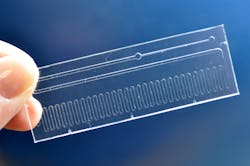POINT-OF-CARE/CANCER DETECTION: NIH network advances optical point-of-care technologies
Increasingly, point-of-care (POC) device developers are turning to optical technologies. An example can be seen in the screening of colorectal cancer. One of the main impediments to screening for this type of cancer is the "ick" factor. (Some patients shy away from testing because of the colon-cleaning preparation required 24 hours ahead of a scheduled colonoscopy. Others refuse a fecal occult blood test, which requires placing a small stool sample on a chemically treated card.) Now, advances in optical point-of-care (POC) technologies may eliminate these barriers.
Irving Bigio, a researcher at Boston University, and colleague Satish Singh at the Boston Veterans Affairs Hospital are testing the use of elastic scattering spectroscopy (ESS) as a prescreening tool for colorectal cancer in a primary care setting. In preliminary clinical studies, the researchers found that assessment of the rectum using a fiber-optic probe can predict the presence of malignant polyps in nearby sections of the colon. This approach requires neither a specialist nor a "clean" colon.
Bigio's research is funded, in part, by a grant from the Center for Innovation in Point-of-Care Technologies for the Future of Cancer Care (CFTCC) at Boston University. The center is part of the Point-of-Care Technologies Research Network (POCTRN) supported by the National Institute of Biomedical Imaging and Bioengineering (NIBIB).Developers and clinicians together
Established in 2007 by NIBIB, the POCTRN addresses a "perceived disconnect between technology developers and clinical needs," says POCTRN program director Brenda Korte. "The network allows researchers and engineers to work with user groups to see what they really need."
Out of these collaborations come devices that move therapeutic procedures or diagnostic measurements down one level from where they currently occur in a clinical setting, says CFTCC director Catherine Klapperich. For example, Bigio's device can move colon cancer screening from a specialized suite requiring a gastroenterologist's expertise to a primary care office.
Support for CFTCC and two other centers—the Point-of-Care Technology Research Center in Primary Care (CPC) at the Center for the Integration of Medicine and Technology (CIMIT) in Boston and the Center for Point-of-Care Technologies Research for Sexually Transmitted Diseases (STD) at Johns Hopkins University—was awarded as part of POCTRN's second round of funding in 2012.
Because the network is relatively small and the budget moderate, the centers function as a resource hub for building partnerships, assessing clinical needs, and matching technology developers with funding sources. "A lot of what I do is scientific matchmaking," says Klapperich. In many cases, clinicians come up with device ideas, but "are so overwhelmed with patient care that they can't do the initial design themselves." CPC principal investigator John Parrish agrees: "Many of the people with the best ideas are clinicians, but they don't have the time, willingness, or training to drive a technology to commercialization. We try to provide that expertise."
Each center offers a variety of services to help translate an idea into a marketable product. These range from engineering design to business planning and understanding the regulatory environment. The centers also provide grants to support technology development and CFTCC provides on-site prototyping.
Sharing a common interest in primary care allows the three centers to leverage their resources. In June 2014, the centers will sponsor a POC technology workshop in Boston. Among the topics covered: the manufacturing process, quality control, performing clinical needs assessments, evaluating POC technologies, and device case studies.
Challenges to POC development
Although POC technologies are popular, real challenges exist in commercializing them. "The potential is huge, but the bar is set quite high in terms of robustness and simplicity," Korte explains. In the case of optical POC technologies, many leverage commercially available subcomponents, often driven by the consumer market. "Sometimes, the specifications of these subcomponents are not suitable for medical POC devices," says Gary Tearney, program leader in optical diagnostics at CIMIT. "Challenges are faced when trying to convince subcomponent manufacturers to develop new subcomponents for a market that has not yet been established."
Using a CPC grant, Tearney, who is also on the faculty of the Wellman Center for Photomedicine, is pursuing a handheld optical device that can noninvasively assess middle ear fluid and diagnose otitis media, a middle ear infection. Two of Tearney's Wellman colleagues are also pursuing optically based POC technologies with CPC grants: Tayyaba Hasan is developing a rapid fluorescence-based test kit to help clinicians identify pathogens and determine appropriate antibiotic therapy, and Seemantini Nadkarni is refining a laser-based device to evaluate the blood's ability to clot.
Testing the limits
In the U.S., commercializing these and other POC devices requires approval by the U.S. Food and Drug Administration (FDA). But a critical factor FDA looks for during its approval process is demonstrated clinical value. "The biggest challenge [regarding regulations] is demonstrating POC devices have clinical value in a particular setting," says Korte.
POCTRN members can do this by introducing their prototype technologies into simulated environments, or real-life "learning laboratories," such as Massachusetts General Hospital's Ambulatory Practice of the Future, a CIMIT-sponsored primary care practice. In this setting, device designers and clinicians continually assess a technology to determine its technical strengths and weaknesses, measure effectiveness, determine how well it integrates into a practice workflow and monitor patient satisfaction.
Lighting the way ahead
Efforts such as POCTRN that unite clinicians, researchers, and engineers offer a model on tailoring technologies so that they meet clinical needs, reduce health care costs, and support patients. As demand grows for lower-cost, easy-to-use devices, Parrish anticipates an upswing in the number of POC projects incorporating optical technologies because "[this area] offers a very exciting interface with rapid diagnosis." Tearney agrees. "Light is inexpensive, safe, and can be provided in a small package. It is also capable of obtaining information about tissue, ranging from chemical or molecular composition to microscopic structure. As a result, it is a powerful form of radiation to build upon for POC applications."
To learn more about the opportunities available at the POCTRN centers, contact Klapperich at [email protected], Penny Ford-Carleton (CPC) at [email protected], or Charlotte Gaydos (STD) at [email protected].
About the Author


